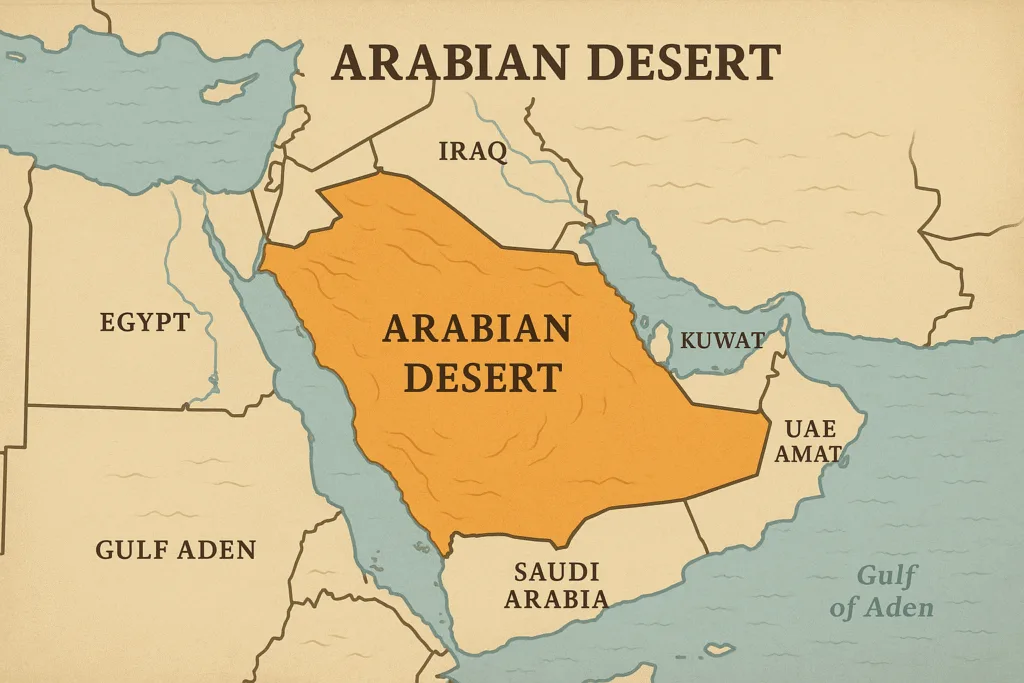Location & Continent
Continent: Asia
Countries: China (Inner Mongolia Autonomous Region)
Coordinates: 39°N, 108°E
Ordos Desert – Map & Street View
Physical Features
Area: ~90,000 km² (part of the larger Ordos Plateau in Inner Mongolia)
Length: ~600 km (east–west)
Width: ~200–300 km (north–south)
Elevation: 900–1,700 m above sea level, forming a plateau encircled by the Great Bend of the Yellow River
Climate & Precipitation
Temperature: Summers reach up to 40 °C; winters drop to −25 °C
Precipitation: 150–250 mm annually, mostly from July to September; evaporation is several times greater than rainfall
Ecological Features
Ecozone: Palearctic (semi-arid and temperate desert zone)
Biome: Temperate desert and steppe transition
Ecoregions: Ordos Plateau Steppe, Mu Us Desert, Hobq Desert (Tengger–Ordos complex)
Flora & Fauna
Flora: Drought-resistant shrubs such as saxaul (Haloxylon ammodendron), wormwood (Artemisia), Caragana, and sand-binding grasses like Psammochloa; vegetation density higher in reforested areas due to China’s Green Great Wall program
Fauna: Goitered gazelle, corsac fox, Mongolian lark, jerboas, steppe eagles, sand grouse, and small populations of wild Bactrian camel in the western reaches
Geology & Notable Features
Geology: The Ordos Desert occupies a structural basin bordered by the Yellow River’s great arc; composed of sand dunes (especially in the Mu Us and Hobq sub-deserts), loess plateaus, and ancient alluvial plains
Notable Features: Hobq (Kubuqi) Desert dunes near the Yellow River; Mu Us Desert reforestation zone; Ordos Plateau coal and rare earth deposits; Dalad Banner dunes; the historic Ordos Loop of the Yellow River shaping its southern boundary
Overview of the Ordos Desert
The Ordos Desert, located in Inner Mongolia, China, is a striking geomorphological feature characterized by its vast sand dunes and unique ecosystem. Spanning approximately 1,000 square kilometers, the desert is often overshadowed by other significant deserts in the world but offers a unique perspective on desert ecosystems.
Geographic Location
The Ordos Desert is situated in the north-central part of China, surrounded by the Loess Plateau to the south, the Yellow River to the east, and the Gobi Desert to the north. Its geographic uniqueness lies in its position at the edge of the Gobi Desert and its transition zone between cold desert and semi-arid lands.
Topography and Climate
The desert features an array of landforms, including massive sand dunes, rocky outcrops, and clay flats. The climate is classified as arid, with high peaks of temperature during summer reaching up to 40°C and icy winters dropping below -20°C. Rainfall is limited, averaging only 200 mm annually, which contributes to its arid conditions.
Flora and Fauna
Despite its harsh conditions, the Ordos Desert hosts a variety of life. Vegetation predominantly comprises xerophytic plants like dry grasses, halophytes, and shrubs that have adapted to withstand extreme temperatures and scarce water supply. The fauna includes several endemic species such as the Mongolian gazelle and various reptiles and insects, displaying remarkable adaptations to desert life.
Human Impact and Culture
The Ordos Desert is home to several Mongolian tribes, who have inhabited this region for centuries. The nomadic lifestyle and rich cultural practices of these people have given rise to a fascinating blend of traditions and environmental adaptations. However, urbanization and industrial activities have begun to impact this delicate ecosystem.
Conservation Efforts
Recognizing the ecological importance of the Ordos Desert, several conservation initiatives have been put in place. These include reforestation programs designed to combat desertification and biodiversity preservation efforts aimed at protecting the native flora and fauna. Local awareness campaigns strive to educate the community on sustainable practices to ensure long-term health for the desert.
Visiting the Ordos Desert
For those considering a visit, the Ordos region offers a range of adventure opportunities. Tourists can explore the stunning landscapes through activities such as trekking, sandboarding, and visiting preserved cultural sites. The semi-nomadic lifestyle can also be experienced through guided tours, providing insights into the unique adaptations of the local people.
Detailed Comparison of Notable Deserts
Below is a comparison of the Ordos Desert with some notable deserts around the world:
| Desert Name | Location | Area (sq km) | Climate | Average Temperature |
|---|---|---|---|---|
| Ordos Desert | Inner Mongolia, China | 1,000 | Arid | 40°C in summer, -20°C in winter |
| Sahara Desert | Africa | 9,200,000 | Hot | 50°C in summer, 5°C in winter |
| Gobi Desert | Mongolia and China | 1,295,000 | Cold | 38°C in summer, -40°C in winter |
| Atacama Desert | Chile | 105,000 | Cold | 25°C in summer, -5°C in winter |
Conclusion
In conclusion, the Ordos Desert is a testament to the resilience of both nature and culture. It embodies a unique landscape where flora and fauna, intertwined with human existence, create a mosaic of life amidst harsh conditions. Increasing awareness and sustainable practices will ensure that this captivating desert can continue to thrive, providing a glimpse into its remarkable environment for generations to come.
References
Government / Official Sources
Ministry of Ecology and Environment, PRC — “Ecological Restoration and Desert Control in the Ordos Plateau Region”
Chinese Academy of Sciences — “Study on Aeolian Sand Movement in the Mu Us Desert, Ordos Plateau”
UNESCO — “Ordos Desert Ecological Zone (Mu Us–Hobq region, Inner Mongolia)”
University Sources
Lanzhou University — “Paleoclimate and Sand Mobility in the Ordos Plateau during the Late Quaternary”
Institute of Geographic Sciences and Natural Resources Research (CAS) — “Vegetation dynamics and human impact in the Ordos Desert over the past 50 years”


